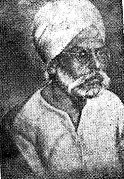Singh ‘Rup’, Harinder, born in 1907, was an eminent Punjabi poet of the neo-classical tradition in which emotion remains subdued. He published his poems in collections entitled Nave pandh (New paths, 1945) and Dunghe vahin (Deep streams, 1947). Rup did not develop a new style or content of his poetry; the subject as well as the technique are traditional. In Dunghe vahin, there is maturity and depth.
Rup was an amateur student of classical painting and had a well-formed taste in matters of painting and architecture, being a scion of the aristocratic Bhai family that enjoyed much respect, honour and some power in the court of Ranjit Singh. His talent has expressed itself better in what are called \’vars\’ or lays which were published in collections like Shanan mere Punjab dian (the glory of my Punjab), Lok varan (Lays of the people), Mamikh di var (the lay of man) and Himala di var (the lay of the Himalaya). The last named was published after his death. Manukh di var narrates the history and evolution of civilisation.
In Himala di var the Himalayan range is the hero, and it describes the pitiable condition of people living at the foot of these mountains with suggestions about improving their lot. The section about the marriage of God Shiva is full of humour of a simple but polite kind. In Sann santali di var (The lay of 1947), he describes with tragic feeling the gory events that took place in the aftermath of independence.
References :
1. Anon, A Guide of Punjabi, Lahore, 1896.
2. Kohli, Surindar Singh, A Critical Study of Adi Granth, Delhi, 1961.
3. Ramdev, Jaginder Singh (ed.), Punjabi Likhari Kosh, Jullundur, 1964.
4. Taran Singh, Sri Guru Granth Sahib Ji da Sahitak Itihas, Amritsar, n.d.
Harinder Rup, born in 1907, stands as a towering figure in the realm of Punjabi neo-classical poetry. His work is distinguished by its refined, measured tone—a deliberate restraint in emotional expression that aligns with the neo-classical ethos. Unlike the overt, passionate expressions found in much of modern verse, Rup’s poetry emphasizes clarity, elegance, and structural precision.
In his notable collections, Nave pandh (New Paths, 1945) and Dunghe vahin (Deep Streams, 1947), Rup sets forth a poetic vision where language becomes a sculpted medium. His work traverses themes of human experience, subtle introspection, and the beauty of everyday life, all rendered with a classical sensibility that respects the art of disciplined poetic form. His verses invite readers into a contemplative space—one where the interplay of imagery and form, balance and precision, provides a window into the nuanced struggles and quiet hopes of the human spirit.
Rup’s style not only served as a bridge between traditional Punjabi aesthetics and modern literary expression but also helped to redefine the boundaries of poetic narrative in his era. His legacy endures in the way later generations of poets draw upon both the timeless gravitas of classical structures and the subtle emotional hues that made his work so distinctive.



